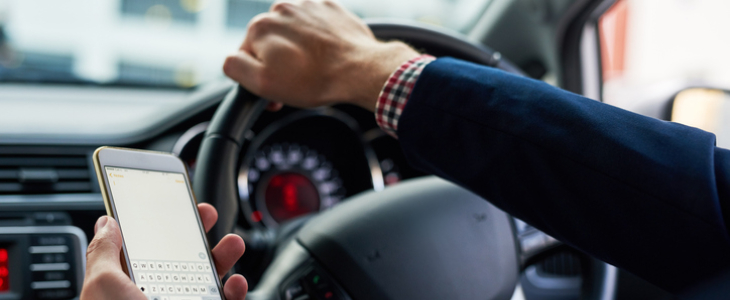Distracted driving has emerged as a significant concern on California’s roads. Distractions, ranging from texting to adjusting music, compromise the safety of both the driver and others. With the rising number of accidents, Californians need to be informed about the implications and consequences of such behavior behind the wheel.
Common Types of Distractions on the Road
- Texting or Using a Cellphone: Sending messages or making calls can divert attention from the road for crucial seconds.
- Adjusting Music or GPS: Fiddling with devices can cause a driver to lose focus on their surroundings.
- Talking to Passengers: Engaging in deep or heated conversations can be just as distracting as other activities.
- Eating and Drinking: Consuming food requires drivers to take their hands off the wheel and eyes off the road.
- Daydreaming: A wandering mind can cause delayed reactions to sudden road events or changes.
- Grooming: Activities like applying makeup or adjusting hair can divert a driver’s attention and hands away from driving tasks.
- External Distractions: Billboards, accidents, or unusual sights can pull a driver’s focus away from their immediate environment.
Statistical Overview: The Dangers Presented
Distracted driving poses a myriad of risks to both drivers and the general public. When a driver’s attention is diverted from the road, even for a few seconds, the chance of missing crucial visual and auditory cues increases exponentially. This can lead to delayed reactions, inability to recognize impending hazards, and poor decision-making. As a result, such distractions become a leading cause of vehicle collisions, often resulting in severe injuries or fatalities. The ripple effect of these accidents also extends to increased insurance premiums, traffic congestion, and emotional trauma for affected families.
In California alone, distracted driving has been a consistent factor in a significant portion of roadway accidents. Recent data suggests that distractions contribute to almost 20% of all traffic collisions in the state. According to the California Highway Patrol, in 2021, 9,733 people were injured and 96 people were killed in crashes in California caused by distracted driving. These numbers underscore the urgency for drivers to remain vigilant and minimize distractions while operating a vehicle.
California Laws on Distracted Driving
In California, the fight against distracted driving has resulted in stringent laws to ensure the safety of all road users. The state’s hands-free law mandates that all drivers use voice-operated or hands-free enabled tech when using electronic devices while driving. Texting, browsing, and even holding a cell phone in hand when behind the wheel is prohibited, irrespective of the driver’s age. Any driver under the age of 18 cannot use a cell phone at all while driving. Violators face fines which can escalate for subsequent offenses, emphasizing the state’s commitment to curbing this dangerous behavior.
In addition to the cell phone regulations, other forms of distractions, like grooming or reading while driving, can also lead to a “reckless driving” charge under California Vehicle Code Section 23103. This statute essentially penalizes any form of careless driving that could endanger oneself or others on the road. Thus, even if a specific act isn’t explicitly mentioned in the law if it’s deemed distracting and hazardous, drivers can face legal consequences.
The Impact of Distracted Driving Accidents
The repercussions of distracted driving accidents extend far beyond immediate vehicle damage. Physically, victims can suffer a range of injuries from minor bruises to life-threatening conditions or even fatalities. The emotional trauma following such incidents can be profound, leading to anxiety, post-traumatic stress disorder (PTSD), or fear of driving. Economically, the fallout includes hefty medical bills, rehabilitation costs, car repairs, and potential loss of income due to prolonged recovery. The societal cost is equally significant, with increased insurance premiums and strain on emergency response services and healthcare systems.
What to Do If You’re Involved in a Distracted Driving Accident
If you find yourself involved in a distracted driving accident, it’s crucial to prioritize safety. Begin by checking for injuries to yourself and any passengers. If the situation allows, move your vehicle to a safe location, away from traffic, to prevent further collisions. It’s essential to then call 911, especially if there are injuries or significant property damage, as prompt medical attention and an official accident report are vital.
After ensuring safety, begin collecting evidence by taking photographs of the accident scene, vehicle damage, and any visible injuries. It’s also important to gather contact and insurance information from all involved parties and note down statements from any witnesses. Even if you believe you might be at fault, avoid making statements that accept blame. Instead, consider consulting with a personal injury attorney to guide you through the subsequent legal and insurance processes.
How a Personal Injury Attorney Can Help
A personal injury attorney offers invaluable assistance after a distracted driving accident. They possess the expertise to navigate the complexities of insurance claims, ensuring victims receive the compensation they deserve. Moreover, they can provide legal representation if the case escalates to court, advocating for the client’s best interests. Their guidance can alleviate much of the stress and uncertainty that often accompanies such traumatic events.
Get Help If You’ve Been Injured by Distracted Driving in Southern California
Distracted driving accidents can be life-altering, but you don’t have to navigate the aftermath alone. Ardalan & Associates is committed to advocating for your rights and ensuring you receive the support and compensation you deserve. Reach out to us today for guidance tailored to your unique situation.
Ardalan & Associates, PLC is a personal injury law firm based in Thousand Oaks, serving all of Southern California, including Los Angeles, Ventura, Kern, and Orange County. We are committed to helping our clients involved in personal injury accidents seek justice and navigate their legal journey.
